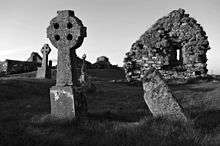Howmore
| Howmore | |
| Scottish Gaelic: Togh Mòr / Tobha Mor | |
 Howmore youth hostel |
|
 Howmore |
|
| Language | Scottish Gaelic |
|---|---|
| English | |
| OS grid reference | NF765362 |
| Civil parish | South Uist |
| Council area | Na h-Eileanan Siar |
| Lieutenancy area | Western Isles |
| Country | Scotland |
| Sovereign state | United Kingdom |
| Post town | ISLE OF SOUTH UIST |
| Postcode district | HS8 |
| Dialling code | 01878 |
| Police | Scottish |
| Fire | Scottish |
| Ambulance | Scottish |
| EU Parliament | Scotland |
| UK Parliament | Na h-Eileanan an Iar |
| Scottish Parliament | Na h-Eileanan an Iar |
Coordinates: 57°18′07″N 7°22′19″W / 57.302°N 7.372°W
Howmore (Scottish Gaelic: Togh Mòr / Tobha Mor[1]) lies on the island of South Uist to the southwest of Loch Druidibeg. The mountain of Haarsal rises to 139 m (456 ft) to the east and immediately south is the smaller settlement of Howbeg. Howmore is also within the parish of South Uist.[2]
Geography
The area is largely flat but is dominated by the mountain Beinn Mhòr. A rewarding day's hillwalking can be had on Beinn Mhor and Hecla [606 m (1,988 ft)] - South Uist's highest hills. Loch Druidibeg Nature Reserve, 3 km (1.9 mi) to the north, is an important site for breeding greylag geese and a sanctuary for the corncrake, now, within Britain, almost unique to the Western Isles. Howmore is situated alongside the A865.[3] The ruins of Flora MacDonald's birthplace can be found near Milton, 11 km (6.8 mi) south of Howmore, marked with a commemorative cairn.
On the southern slopes of Beinn Mhor is the wooded area of Allt Volagir, one of the few areas of natural woodland left in the Hebrides.
History

The village is perhaps best known for its remarkable collection of ruined churches and chapels. The most striking remains are of the Teampull Mor, the "Large Church" or St Mary's, of which only part of the east gable remains. This church probably dates back to the 13th century and it was used as the parish church.
The islands were all wooded once until the arrival of the Vikings who are traditionally blamed for clearing the trees (though this fact is disputed).
Community
Church
At the time of the Reformation, Howmore turned to Protestantism, though 95% of the population of South Uist remained Roman Catholic. Howmore Church, built in 1858, is therefore rather unusual; doubly so as it is one of the few churches in Scotland with a central Communion table. The church is white-harled and used as a landmark by fishermen off the west coast.
Leisure
Howmore is also home to one of Scotland's best collections of thatched buildings. The youth hostel is operated by Gatliff Hebridean Hostels Trust. It is located in a white-painted thatched building of remarkable charm: and with stunning views to the east across ruined churches towards the peak of Hecla.
Images
 Howmore - Landscape
Howmore - Landscape Howmore - Beach 1
Howmore - Beach 1 Howmore - Beach 2
Howmore - Beach 2
References
- ↑ "Overview of Howmore". Scottish Places. Retrieved 23 December 2014.
- ↑ "Details of Howmore". Scottish Places. Retrieved 23 December 2014.
- ↑ "A865/South Uist". Sabre. Retrieved 23 December 2014.
External links
| Wikimedia Commons has media related to Howmore. |
- Canmore - South Uist, Howmore, Old Churches and Chapels site record
- Canmore - South Uist, Howmore site record